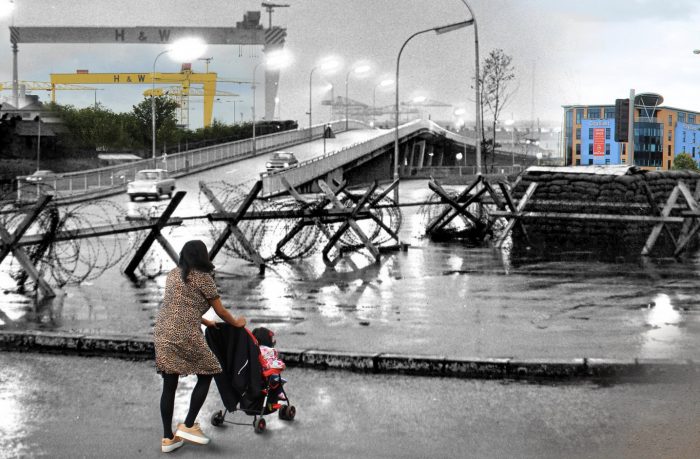I was trying to remember who it was that said, “peace in our time.”
I sat halfway down the length of a bus with a window seat on my way to Belfast. Looking out over paddocks so green, they seemed to emit their own light.
That line sounded like, at best, a dream, at worst, a political promise. Peace carried a feeling of impossibility in a world of endless conflicts, nuclear weapons, arms trading, and disputes over territories.
I barely made it home to Australia before words like pandemic, Covid, and Wuhan started becoming everyday expressions. In that time, for a fleeting period, I dared to believe our wars would only be against the virus—that we may unite against this threat.
But China still persecuted the Uyghur people. Israel and Hamas exchanged missiles and airstrikes. The military turned on its own people in Myanmar. Demonstrations in Hong Kong were crushed. India and China clashed. North Korea threatened the United States. Russia developed more weapons, boasting about their potential to annihilate in the same way I’d expect medical breakthroughs and social justice achievements to be celebrated.
The bus grinded past the docklands. Belfast was cold, low-slung grey skies as if I’d become color blind.
I’ve talked about those skies ever since, making their impression on me the same way that sunflowers did in Italy, or the day bright sun broke through in Cardiff. Days of muted light where I live now take me straight back to memories of Belfast. As if stepping into a black and white photograph. And there was that breeze, pressing gently but freezing, the lumpy cold of a bite of ice cream going down too slowly. Air weighted with damp and rain falling somewhere else.
The bus dropped me beside a church. I stopped outside the grace of its architecture.
There’s a pearl of old wisdom about if walls could talk, and I thought what that building might say about the troubles. The Troubles was a period between the late 1960s to late 1990s in Northern Ireland. A time of deadly conflict, including Catholics pitted against Protestants, the Irish Republican Army against the British Army, and even disputes over which flag to raise.
In many ways, I wasn’t ready for Belfast.
Beforehand I’d explored Dublin. I walked from the new city to the old, lost before finding the Writer’s Museum and dawdling through exhibits. In pubs, everyone wanted to know my accent, or if I followed rugby, apologised for talking too much, and strangers said good night as they went out the pub door.
Belfast, by comparison was sombre, possibly moody, a place where I’d have to work harder at that getting to know you conversation.
Soon I was collected and driven to the peace wall. It stretches through neighborhoods, separating Catholic districts from Protestant areas. Graffiti and images swirled. Pictures of men in balaclavas, brandishing guns, and rocket launchers. Images of hunger striker Bobby Sands, a person adored as a hero by many so that I imagined his image hanging in homes next to Jesus on crosses.
Eventually, someone handed me a felt pen, and I wrote a rambling message on the wall about what unites Northern Ireland has to be stronger than what divides it.
The government had promised to remove the wall, so officially it’s destined for the same fate as the Berlin wall. I pictured the scrawl of my message fragmenting under jackhammers but the spirit of it lifting with dust, floating alongside the dreams of the Northern Ireland people. But the uncomfortable truth is that people living near it feel safer as long as the structure towers are over them.
I walked the sites of attacks, and killings were pointed out. Often outside modest, quiet homes, as if all that would ever happen in those spaces where people were strolling in occasional sunshine or kids walking to school.
Police cars passed us, heavily fortified against rocks and petrol bombs. I heard about the journalist Lyra McKee who wrote about the troubles, shot dead during rioting in 2019. I also heard about the emergence of the new Irish Republican Army. I saw the graffiti, its hatred vivid, hastily sprayed from cans, pink against the grime of walls.
Through all that, I spoke to people who were intrigued that an Australian could take so much interest. There was a theme to what they told me, spoken so passionately I almost fell back from the force of their eye contact. They believed in peace.
They believed in it for them, but especially their children. One told me that perhaps it would take a new generation for the hate to die out.
Northern Ireland is a relatively small stage globally, but it challenges us. If we cannot secure peace there, what does it say about our own aspirations of peace in our time?
If we cannot find harmony amongst people living in the same land, using the same language, speaking of a deep desire for freedom and safety, how can we seriously hope to achieve it anywhere else?
I imagine Belfast without the peace wall. Instead, a monument marking its former route and a portion of the wall installed in the Ulster Museum. But the real exhibit was in the streets outside, where people who once opposed each other across barricades, fled from rubber bullets, lost loved ones, and lived through the heat of explosions now mingled together without fear.
It was Neville Chamberlin, former British Prime Minister, who proclaimed peace in our time.
He ultimately failed in that goal. It’s my hope the sheer will of the people of Northern Ireland and the dried ink on the 1998 “Good Friday agreement” ending the Troubles endures and achieves the peace they deserve.
~











Read 4 comments and reply